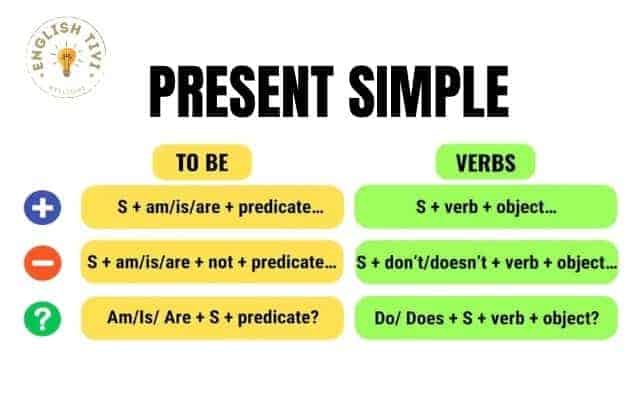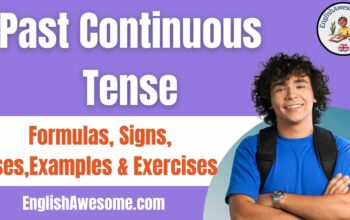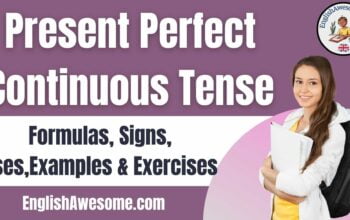Introduction
Present Simple Tense indicates an action that happens in the present, but it isn’t necessary for actions to happen right now. The simple present tense indicates, unchanging situations, general truths, scientific facts, habits, fixed arrangements, and frequently occurring events.
⏩ Sign Up to Get Bonus
Structure of Present Simple Tense
POSITIVE FORMS (+) :
- Subject ( I, You, We, They ) + V1 ( First Form of Verb )
- Subject ( He, She, It ) + Verb – S / ES / IES

Examples:
- My mother lets me go out with my friends.
- I prefer my coffee black.
- She puts the keys on the table.
- The teacher shouts at us all the time.
- I have two brothers.
- Coffee grows in Brazil.
NEGATIVE FORMS (-) :
- Subject ( I, You, We, They ) + do not / don’t + V1 ( First Form of Verb )
- Subject ( He, She, It ) + does not / doesn’t + V1 ( First Form of Verb )
Examples:
- My mother does not (doesn’t) let me go out with my friends.
- I do not (don’t) prefer my coffee black.
- She does not (doesn’t) put the keys on the table.
- The teacher does not (doesn’t) shout at us all the time.
- I do not (don’t) have two brothers.
- Coffee does not (doesn’t) grow in Brazil.
QUESTION FORMS (?) :
- Do + Subject ( I, You, We, They ) + V1 ( First Form of Verb )
- Does + Subject ( He, She, It ) + V1 ( First Form of Verb )
Examples:
- Does your mother let you go out with your friends?
- Do you prefer your coffee black?
- Does she put the keys on the table?
- Does the teacher shout at us all the time?
- Do I have two brothers?
- Are you a teacher?
- Is your father tired?
SHORT ANSWER FORMS ( + / – ) :
- YES / NO + Subject ( I, You, We, They )+ do / do not (don’t)
- YES / NO + Subject ( He, She, It ) + does / does not (doesn’t)
Examples:
- Do you go to school? No, I do not.
- Does she clean her room? Yes, she does.
| POSITIVE (+) | NEGATIVE (-) | QUESTION (?) |
| I start | I do not (don’t) start | Do I start |
| You start | You do not (don’t) start | Do you start |
| He starts | He does not (doesn’t) start | Does he start |
| She starts | She does not (doesn’t) start | Does she start |
| It starts | It does not (doesn’t) start | Does it start |
| We start | We do not (don’t) start | Do we start |
| You start | You do not (don’t) start | Do you start |
| They start | They do not (don’t) start | Do they start |
Present Simple Tense Uses
1. We use the present simple when something is generally or always true.
Examples:
- The sun rises in the East and sets in the West.
- He drinks tea at breakfast.
- She only eats fish.
- They watch television regularly.
- People need food.
- It snows in winter here.
- Two and two make four.
2: Similarly, we need to use this tense for a situation that we think is more or less permanent.
Examples:
- Anna often goes to school by bicycle.
- He gets up early every morning.
- We catch the bus every morning.
- It rains every afternoon in the hot season.
- They drive to Monaco every summer.
- Where do you live?
- She works in a bank.
- I don't like mushrooms.
3: The next use is for habits or things that we do regularly. We often use adverbs of frequency.
Examples:
- I play tennis every Tuesday.
- I don't travel very often.
- Christmas Day falls on a Monday this year.
- The plane leaves at 5.00 tomorrow morning.
- Ramadan doesn’t start for another 3 weeks.
4: We can also use the present simple for short actions that are happening now. The actions are so short that they are finished almost as soon as you've said the sentence.
Examples:
- They don’t ever agree with us.
- I think you are right.
- She doesn’t want you to do it.
- He takes the ball, he runs down the wing, and he scores!
Recognition of Present Simple Tense
The sentence contains adverbs indicating frequency such as:
- Every day/ week/ month…
- Often, usually, frequently
- Sometimes, occasionally
- Always, constantly
- Seldom, rarely
Attention
1. In Simple Present Tense, we add the suffix -s at the end of the verbs for the third singular subject ( He, She, It ). On the other hand, we use the first forms of the verbs for other subjects ( I, You, We, You, They).
2. Although we add the suffix -s at the end of the verb for the third singular subjects in positive sentences, we remove the suffix -s at the end of the verb in questions and negative sentences because of being used ‘does’ or ‘doesn’t’ as an auxiliary verb.
Lesson: Present Progressive Tense
Above is all helpful information about it. I wish you all good study!
In addition, you can refer such as English stories, grammar, … are constantly updated on Englishtivi.com.
Subscribe to the English tivi channel on Youtube to improve your English learning skills!





